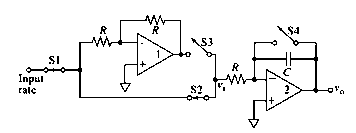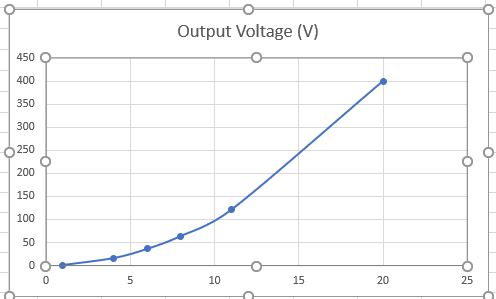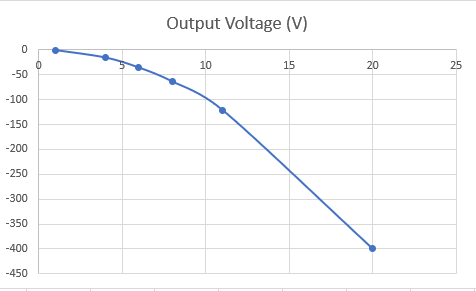
(a)
Interpretation:
The function of the operational amplifier 1 should be determined.
Concept introduction:
The operational amplifier is a high gain device and it amplifies the voltage. Generally, a voltage amplifier has a single output and differential input. So, basically, an operational amplifier produces an output much higher than the input voltage. The output voltage could be thousands of times higher than the input voltage.
Here, the given electronic circuit is as below:

Explanation of Solution
Given information:

The operational amplifier is a high gain device and it amplifies the voltage. Generally, a voltage amplifier has a single output and differential input. So basically, an operational amplifier produces an output much higher than the input voltage. The output voltage could be thousands of times higher than the input voltage.
Here the given electronic circuit is as below:

It can be seen that the operational amplifier 1 here performing the function of inverting voltage amplifier.
(b)
Interpretation:
The function of the operational amplifier 2 should be determined.
Concept introduction:
The operational amplifier is a high gain device and it amplifies the voltage. Generally, a voltage amplifier has a single output and differential input. So, basically, an operational amplifier produces an output much higher than the input voltage. The output voltage could be thousands of times higher than the input voltage.
Here the given electronic circuit is as below

Explanation of Solution
The operational amplifier is a high gain device and it amplifies the voltage. Generally, a voltage amplifier has a single output and differential input. So basically, an operational amplifier produces an output much higher than the input voltage. The output voltage could be thousands of times higher than the input voltage.
Here the given electronic circuit is as below:

It can be seen that the operational amplifier 2 here performing the function of integrating circuit and hence the integration.
(c)
Interpretation:
The output voltage during the interval
Concept introduction:
The operational amplifier is a high gain device and it amplifies the voltage. Generally, a voltage amplifier has a single output and differential input. So, basically, an operational amplifier produces an output much higher than the input voltage. The output voltage could be thousands of times higher than the input voltage.
Here the given electronic circuit is as below

Explanation of Solution
The operational amplifier is a high gain device and it amplifies the voltage. Generally, a voltage amplifier has a single output and differential input. So basically, an operational amplifier produces an output much higher than the input voltage. The output voltage could be thousands of times higher than the input voltage.
Here the given electronic circuit is as below:

Here the input voltage
Where
As per the problem switches
Here, the output signal can be given by the formula as below
Now assume
Substitute the values in the above equation and simplify, the result obtained is
The integrating voltage at different time intervals is given as:
| Time(s) | Output Voltage (V) |
| 1 | 1 |
| 4 | 16 |
| 6 | 36 |
| 8 | 64 |
| 11 | 121 |
| 20 | 40 |
The plot can be obtained as shown below:

(d)
Interpretation:
The output voltage during the second interval
Concept introduction:
The operational amplifier is a high gain device and it amplifies the voltage. Generally, a voltage amplifier has a single output and differential input. So, basically, an operational amplifier produces an output much higher than the input voltage. The output voltage could be thousands of times higher than the input voltage.
Here the given electronic circuit is as below

Explanation of Solution
The operational amplifier is a high gain device and it amplifies the voltage. Generally, a voltage amplifier has a single output and differential input. So basically, an operational amplifier produces an output much higher than the input voltage. The output voltage could be thousands of times higher than the input voltage.
Here the given electronic circuit is as below

Here the input voltage
Where
As per the problem switches
Here the output signal can be given by the formula as below
Where
Therefore, it can be said that
The output of the second operational amplifier which is actually the final output can be given by the equation as below:
Where
Now assume
Substitute the values in the above equation and simplify, the result obtained is
The integrating voltage at different time intervals is given as:
| Time(s) | Output Voltage (V) |
| 1 | -1 |
| 4 | -16 |
| 6 | -36 |
| 8 | -64 |
| 11 | -121 |
| 20 | -40 |
The plot can be obtained as shown below:

(e)
Interpretation:
The output voltage
Concept introduction:
The operational amplifier is a high gain device and it amplifies the voltage. Generally, a voltage amplifier has a single output and differential input. So, basically, an operational amplifier produces an output much higher than the input voltage. The output voltage could be thousands of times higher than the input voltage.
Here the given electronic circuit is as below

Explanation of Solution
The operational amplifier is a high gain device and it amplifies the voltage. Generally, a voltage amplifier has a single output and differential input. So basically, an operational amplifier produces an output much higher than the input voltage. The output voltage could be thousands of times higher than the input voltage.
Here the given electronic circuit is as below

Since there is no current so capacitor will discharge. And circuit will act as differentiator.
Further, it can be re-written as
The output can be given as
(f)
Interpretation:
The advantages and disadvantages of the given circuit over the normal amplifier should be described.
Concept introduction:
The operational amplifier is a high gain device and it amplifies the voltage. Generally, a voltage amplifier has a single output and differential input. So, basically, an operational amplifier produces an output much higher than the input voltage. The output voltage could be thousands of times higher than the input voltage.
Here the given electronic circuit is as below

Explanation of Solution
The operational amplifier is a high gain device and it amplifies the voltage. Generally, a voltage amplifier has a single output and differential input. So basically, an operational amplifier produces an output much higher than the input voltage. The output voltage could be thousands of times higher than the input voltage.
Here the given electronic circuit is as below

Since there is no current so capacitor will discharge. And circuit will act as differentiator.
In general, the normal operational amplifier circuit can be used as a differentiator circuit only. But the given integrating circuit can be used as differentiator as well as integrator. Just one disadvantage is that the given circuit has higher noise level as compared to the normal circuit.
(g)
Interpretation:
The scenario if the input signal gets changes with the slope during the measurement cycle should be determined.
Concept introduction:
The operational amplifier is a high gain device and it amplifies the voltage. Generally, a voltage amplifier has a single output and differential input. So, basically, an operational amplifier produces an output much higher than the input voltage. The output voltage could be thousands of times higher than the input voltage.
Here the given electronic circuit is as below

Explanation of Solution
The operational amplifier is a high gain device and it amplifies the voltage. Generally, a voltage amplifier has a single output and differential input. So basically, an operational amplifier produces an output much higher than the input voltage. The output voltage could be thousands of times higher than the input voltage.
Here the given electronic circuit is as below

Since there is no current so capacitor will discharge. And circuit will act as differentiator.
The output of the second operational amplifier which is actually the final output can be given by the equation as below:
Where
Now assume
Substitute the values in the above equation and simplify, the result obtained is
Further it can be written that
(h)
Interpretation:
The result obtained if the two-time intervals are separated by a time delay
Concept introduction:
The operational amplifier is a high gain device and it amplifies the voltage. Generally, a voltage amplifier has a single output and differential input. So, basically, an operational amplifier produces an output much higher than the input voltage. The output voltage could be thousands of times higher than the input voltage.
Here the given electronic circuit is as below

Explanation of Solution
The operational amplifier is a high gain device and it amplifies the voltage. Generally, a voltage amplifier has a single output and differential input. So basically, an operational amplifier produces an output much higher than the input voltage. The output voltage could be thousands of times higher than the input voltage.
Here the given electronic circuit is as below

For the given circuit the during the first time interval
Now if the two-time intervals are separated by a time delay
(i)
Interpretation:
The result if the two-time intervals were of different duration should be determined.
Concept introduction:
The operational amplifier is a high gain device and it amplifies the voltage. Generally, a voltage amplifier has a single output and differential input. So, basically, an operational amplifier produces an output much higher than the input voltage. The output voltage could be thousands of times higher than the input voltage.
Here the given electronic circuit is as below

Explanation of Solution
The operational amplifier is a high gain device and it amplifies the voltage. Generally, a voltage amplifier has a single output and differential input. So basically, an operational amplifier produces an output much higher than the input voltage. The output voltage could be thousands of times higher than the input voltage.
Here the given electronic circuit is as below

As its known that, if the two-time intervals are same then the plot of the output voltage is same in magnitude and opposite in sign for both the interval. But if the two-time intervals are of different duration then the magnitude of output signal will be different for both the time periods.
(j)
Interpretation:
The reason should be discussed for why the time interval is desirable to be as large as possible in measuring enzyme
Concept introduction:
The operational amplifier is a high gain device and it amplifies the voltage. Generally, a voltage amplifier has a single output and differential input. So, basically, an operational amplifier produces an output much higher than the input voltage. The output voltage could be thousands of times higher than the input voltage.
Here the given electronic circuit is as below:

Explanation of Solution
The operational amplifier is a high gain device and it amplifies the voltage. Generally, a voltage amplifier has a single output and differential input. So basically, an operational amplifier produces an output much higher than the input voltage. The output voltage could be thousands of times higher than the input voltage.
Here the given electronic circuit is as below

Since there is no current so capacitor will discharge. And circuit will act as differentiator.
The output of the second operational amplifier which is actually the final output can be given by the equation as below:
Where
Now, assume
Substitute the values in the above equation and simplify, the result obtained is
If the time gets larger then the output voltage also gets larger.
Enzyme kinematics are generally time-consuming process. So, its desirable to have larger time.
Want to see more full solutions like this?
Chapter 3 Solutions
Principles of Instrumental Analysis, 6th Edition
- presented by Morallen Lig Intermine the hand product for the given mution by adding atoms, bonds, nonhonding diarion panda скуль Step 3: Comp the draw the product Step 2: Agama workup Compithe 429 ملولةarrow_forwardReaction A 0,0arrow_forwardpresented by Morillon Leaning Predict the organic product for the min кусур HSC Adithane carved arnown to come than that to the condon slchroruis in acid in in aquishri with ноюarrow_forward
- 6.15PM Sun Mar 30 K Draw the major product of this reaction. Include any relevant stereochemistry. Ignore inorganic byproducts. Problem 1 of O H [PhзPCH2CH3]*C|¯ NaH Drawing > Q Atoms, Bonds and Draw or tap a nearrow_forward8:17 PM Sun Mar 30 Draw the major product of this reaction. Ignore inorganic byproducts. HSCH2CH2CH2SH, BF3 Probler Drawing Ato Bonds Clarrow_forwardpresented by Mr L How the coprion. (Il Done in no wraction, dew the starting redential) доarrow_forward
- 8:16 PM Sun Mar 30 K Draw the major product of this reaction. Ignore inorganic byproducts. Proble 1. CH3MgBr 2. H3O+ F Drawingarrow_forwardо но оarrow_forwardName the major organic product of the following action of 4-chloro-4-methyl-1-pentanol in neutral pollution 10+ Now the product. The product has a molecular formula f b. In a singly hain, the starting, material again converts into a secule with the molecular kormula CIO. but with comply Draw the major organic structure inhalationarrow_forward
- Macmillan Learning Alcohols can be oxidized by chromic acid derivatives. One such reagent is pyridinium chlorochromate, (C,H,NH*)(CICTO3), commonly known as PCC. Draw the proposed (neutral) intermediate and the organic product in the oxidation of 1-butanol by PCC when carried out in an anhydrous solvent such as CH₂C₁₂. PCC Intermediate OH CH2Cl2 Draw the intermediate. Select Draw Templates More с H Cr о Product Draw the product. Erase Select Draw Templates More H о Erasearrow_forwardIf I have 1-bromopropene, to obtain compound A, I have to add NaOH and another compound. Indicate which compound that would be. A C6H5 CH3arrow_forwardProvide the reagents for the following reactions.arrow_forward
 Physical ChemistryChemistryISBN:9781133958437Author:Ball, David W. (david Warren), BAER, TomasPublisher:Wadsworth Cengage Learning,
Physical ChemistryChemistryISBN:9781133958437Author:Ball, David W. (david Warren), BAER, TomasPublisher:Wadsworth Cengage Learning, Chemistry for Engineering StudentsChemistryISBN:9781285199023Author:Lawrence S. Brown, Tom HolmePublisher:Cengage Learning
Chemistry for Engineering StudentsChemistryISBN:9781285199023Author:Lawrence S. Brown, Tom HolmePublisher:Cengage Learning Principles of Instrumental AnalysisChemistryISBN:9781305577213Author:Douglas A. Skoog, F. James Holler, Stanley R. CrouchPublisher:Cengage Learning
Principles of Instrumental AnalysisChemistryISBN:9781305577213Author:Douglas A. Skoog, F. James Holler, Stanley R. CrouchPublisher:Cengage Learning Principles of Modern ChemistryChemistryISBN:9781305079113Author:David W. Oxtoby, H. Pat Gillis, Laurie J. ButlerPublisher:Cengage Learning
Principles of Modern ChemistryChemistryISBN:9781305079113Author:David W. Oxtoby, H. Pat Gillis, Laurie J. ButlerPublisher:Cengage Learning




